人教版七年级英语unit4where's my schoolbag全英文说课课件
- 格式:ppt
- 大小:2.49 MB
- 文档页数:19
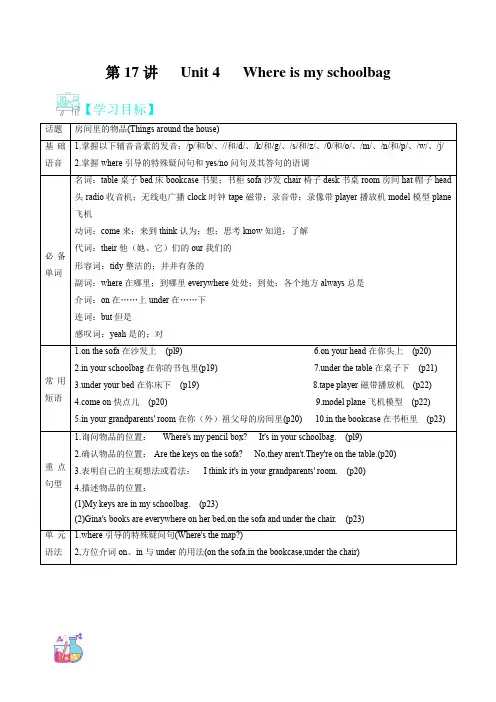
第17讲Unit 4 Where is my schoolbag【学习目标】话题房间里的物品(Things around the house)基础语音1.掌握以下辅音音素的发音:/p/和/b/、//和/d/、/k/和/g/、/s/和/z/、/0/和/o/、/m/、/n/和/p/、/w/、/j/2.掌握where引导的特殊疑问句和yes/no问句及其答句的语调必备单词名词:table桌子bed床bookcase书架;书柜sofa沙发chair椅子desk书桌room房间hat帽子head 头radio收音机;无线电广播clock时钟tape磁带;录音带;录像带player播放机model模型plane 飞机动词:come来;来到think认为;想;思考know知道;了解代词:their他(她、它)们的our我们的形容词:tidy整洁的;井井有条的副词:where在哪里;到哪里everywhere处处;到处;各个地方always总是介词:on在……上under在……下连词:but但是感叹词:yeah是的;对常用短语1.on the sofa在沙发上(pl9) 6.on your head在你头上(p20)2.in your schoolbag在你的书包里(p19)7.under the table在桌子下(p21)3.under your bed在你床下(p19)8.tape player磁带播放机(p22)e on快点儿(p20)9.model plane飞机模型(p22)5.in your grandparents' room在你(外)祖父母的房间里(p20) 10.in the bookcase在书柜里(p23)重点句型1.询问物品的位置:-Where's my pencil box?-It's in your schoolbag.(pl9)2.确认物品的位置:-Are the keys on the sofa?-No,they aren't.They're on the table.(p20)3.表明自己的主观想法或看法:I think it's in your grandparents' room.(p20)4.描述物品的位置:(1)My keys are in my schoolbag.(p23)(2)Gina's books are everywhere on her bed,on the sofa and under the chair.(p23)单元语法1.where引导的特殊疑问句(Where's the map?)2,方位介词on、in与under的用法(on the sofa,in the bookcase,under the chair)【基础知识】1、Where are my books'?我的书在哪里?(教材第19页Ia) 考频:★★★本句是由where引导的特殊疑问句。
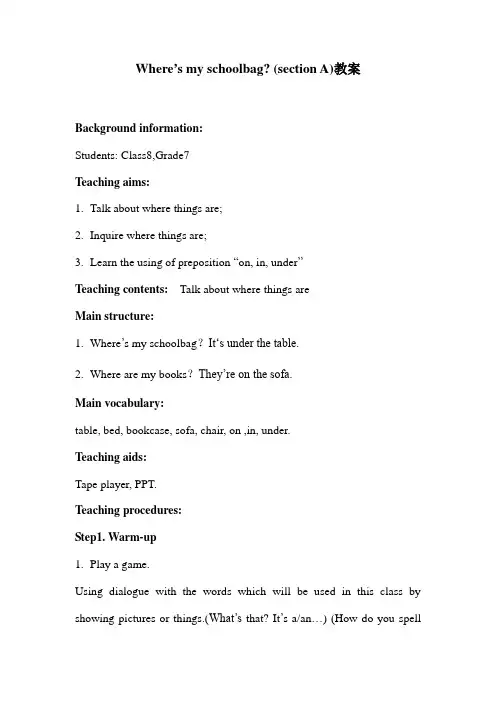
Where’s my schoolbag? (section A)教案Background information:Students: Class8,Grade7Teaching aims:1.Talk about where things are;2.Inquire where things are;3.Learn the using of preposition “on, in, under”Teaching contents: Talk about where things areMain structure:1.Where’s my schoolbag?It‘s under the table.2.Where are my books?They’re on the sofa.Main vocabulary:table, bed, bookcase, sofa, chair, on ,in, under.Teaching aids:Tape player, PPT.Teaching procedures:Step1. Warm-up1.Play a game.Using dialogue with the words which will be used in this class by showing pictures or things.(What’s that? It’s a/an…) (How do you spellit? ……)Step2. Presentation1.Let’s learnlearn the preposition of “in on under”.(Using cartoon pictures to help students understand these three words.)2.Let’s chant3.Pair workShow two things’ positions to teach target language (sentence).---- Where’s/Where’re …?---- It’s/They’re on/in/under the ….Look at the pictures and do the pair work.4.Activity 1aMatch the words with the pictures.Step3. Practice1.Do the exercises2.Do some listening practicesStep4.ConsolidetationPlay a game (Memory challenge).Step5. Homework1.Copy and recite the new words.2.Make a conversation to describe your room.Blackboard design:Where is-----? Where are-----?It’s on/in/under-----. They’re on/in/under-----.Lesson plan for Unit4 Where’s my schoolbag?(Section A, period 1)Teaching aims:1. Language goalsKey vocabulary: table, bed, bookcase, sofa, chair, where, on, under. Target language: Where’s my schoolbag? It’s under the table.Where are my books? They’re on the sofa2. Ability goalsTalk about where things are.Train the students’ communicative competence.3. Moral goalsKeep your room and tidy.Teaching important points:1. New words.2. How to talk about where things are.Teaching difficult points:1. Prepositions of place: in, on, under.2. Prepositional phrases: on the sofa, under the bed, etc.Teaching method:TBLTeaching procedures:Step1 Warming UpRevise some school things by asking questions: T: what is this? ----S: It is a/an…T: What are these? ----- S: They areStep2 Learn the new wordsShow the picture of my bedroom on the screen.Teach the new words: chair, table, bed ,bookcase, sofa.Read the words over and over again until the students can name each item fluently.Best eyes (read the words as quickly as they can)Pretend to look for my schoolbag here and there.T: I can’t find my schoolbag? Where is it? Do you know?Show the schoolbag in/on/under the chair.Let students perform as what teacher said.Step3 Practice(1) Present the key sentence patterns by using box, ball and erasers.(e.g., Where’s the ball? It’s in / on/ under the box.Where are the erasers? They’re in/on/under the box.)(2) Practice the key sentence patterns by pictures. (Q & A)(3) Pair work: choose some volunteer students to act out their own conversations.(4) Guessing game: guide the students to say out the positions of the things by using the sentence patterns.Step 4 SummarySummarize what students have learnt in this lesson.Step 5 Homework(1) Keep your room tidy and clean.(2) Use “in” “on” “under” to describe your bedroom.Blackboard design:总堂课,课堂气氛很活跃,学生积极发言,课堂效果不错。
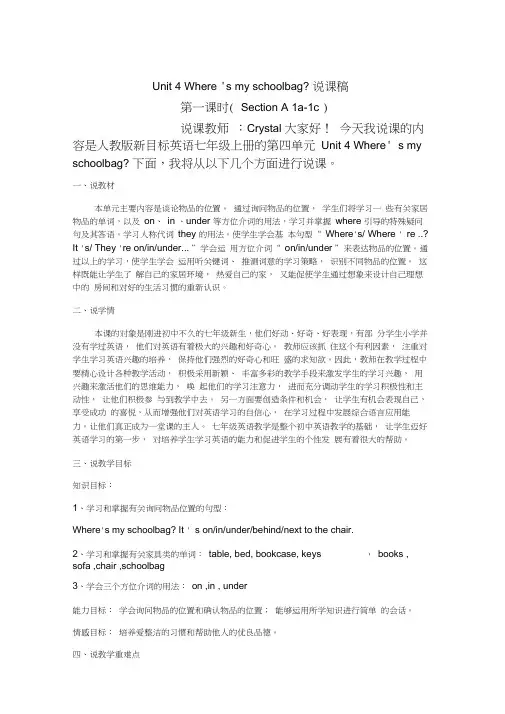
Unit 4 Where 's my schoolbag? 说课稿第一课时( Section A 1a-1c )说课教师:Crystal 大家好!今天我说课的内容是人教版新目标英语七年级上册的第四单元Unit 4 Where' s my schoolbag? 下面,我将从以下几个方面进行说课。
一、说教材本单元主要内容是谈论物品的位置。
通过询问物品的位置,学生们将学习一些有关家居物品的单词,以及on、in 、under 等方位介词的用法,学习并掌握where 引导的特殊疑问句及其答语。
学习人称代词they 的用法。
使学生学会基本句型“ Where's/ Where ' re ..? It 's/ They 're on/in/under... ”学会运用方位介词“ on/in/under ”来表达物品的位置。
通过以上的学习,使学生学会运用听关键词、推测词意的学习策略,识别不同物品的位置。
这样既能让学生了解自己的家居环境,热爱自己的家,又能促使学生通过想象来设计自己理想中的房间和对好的生活习惯的重新认识。
二、说学情本课的对象是刚进初中不久的七年级新生,他们好动、好奇、好表现,有部分学生小学并没有学过英语,他们对英语有着极大的兴趣和好奇心。
教师应该抓住这个有利因素,注重对学生学习英语兴趣的培养,保持他们强烈的好奇心和旺盛的求知欲。
因此,教师在教学过程中要精心设计各种教学活动,积极采用新颖、丰富多彩的教学手段来激发学生的学习兴趣,用兴趣来激活他们的思维能力,唤起他们的学习注意力,进而充分调动学生的学习积极性和主动性,让他们积极参与到教学中去。
另一方面要创造条件和机会,让学生有机会表现自己,享受成功的喜悦,从而增强他们对英语学习的自信心,在学习过程中发展综合语言应用能力。
让他们真正成为一堂课的主人。
七年级英语教学是整个初中英语教学的基础,让学生迈好英语学习的第一步,对培养学生学习英语的能力和促进学生的个性发展有着很大的帮助。
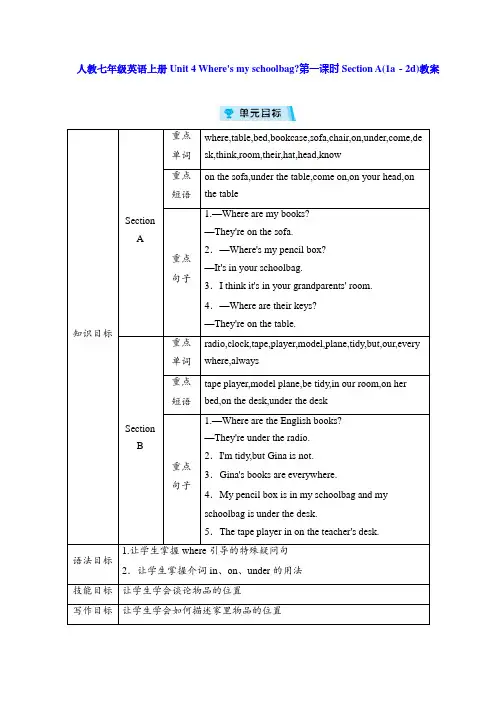
人教七年级英语上册Unit 4 Where's my schoolbag?第一课时Section A(1a-2d)教案知识目标SectionA重点单词where,table,bed,bookcase,sofa,chair,on,under,come,desk,think,room,their,hat,head,know重点短语on the sofa,under the table,come on,on your head,onthe table重点句子1.—Where are my books?—They're on the sofa.2.—Where's my pencil box?—It's in your schoolbag.3.I think it's in your grandparents' room.4.—Where are their keys?—They're on the table.SectionB重点单词radio,clock,tape,player,model,plane,tidy,but,our,everywhere,always重点短语tape player,model plane,be tidy,in our room,on herbed,on the desk,under the desk重点句子1.—Where are the English books?—They're under the radio.2.I'm tidy,but Gina is not.3.Gina's books are everywhere.4.My pencil box is in my schoolbag and myschoolbag is under the desk.5.The tape player in on the teacher's desk.语法目标1.让学生掌握where引导的特殊疑问句2.让学生掌握介词in、on、under的用法技能目标让学生学会谈论物品的位置写作目标让学生学会如何描述家里物品的位置情感目标促使学生了解自己的家居环境,热爱自己的家,使学生养成干净、整洁、合理摆放物品的好习惯第一课时Section A(1a-2d)重点单词where ad v. 在哪里;到哪里table n. 桌子bed n. 床bookcase n. 书架;书柜sofa n. 沙发chair n. 椅子on prep. 在……上under prep. 在……下come v. 来;来到desk n. 书桌think v. 认为;想;思考room n. 房间their pron. 他(她、它)们的hat n. 帽子head n. 头重点短语on the sofa在沙发上under the table在桌子底下come on 快点儿on your head在你的头上重点句子1.—Where are my books? 我的书在哪里?—They're on the sofa. 它们在沙发上。
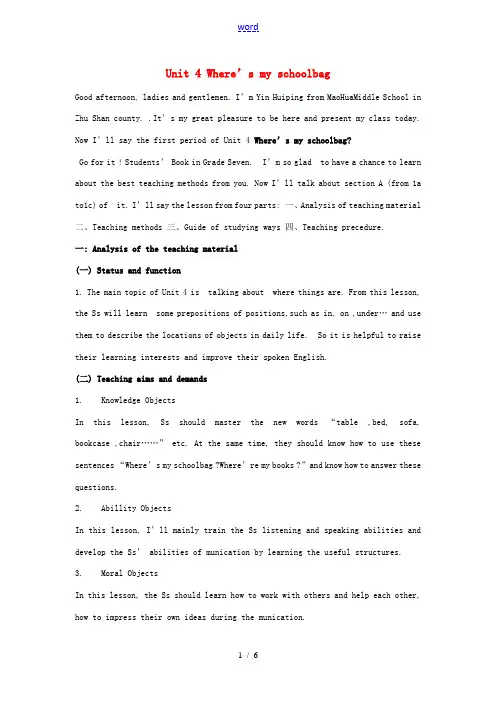
Unit 4 Where’s my schoolbagGood afternoon, ladies and gentlemen. I’m Yin Huiping from MaoHuaMiddle School in Zhu Shan county. .It’s my great pleasure to be here and present my class today. Now I’ll say the first period of Unit 4 Where’s my schoolbag?Go for it ! Students’Book in Grade Seven. I’m so glad to have a chance to learn about the best teaching methods from you. Now I’ll talk about section A (from 1a to1c) of it. I’ll say the lesson from four parts: 一、Analysis of teaching material 二、Teaching methods 三、Guide of studying ways 四、Teaching precedure.一: Analysis of the teaching material(一) Status and function1. The main topic of Unit 4 is talking about where things are. From this lesson, the Ss will learn some prepositions of positions,such as in, on ,under… and use them to describe the locations of objects in daily life. So it is helpful to raise their learning interests and improve their spoken English.(二) Teaching aims and demands1. Knowledge ObjectsIn this lesson, Ss should master the new words “table ,bed, sofa, bookcase ,chair……” etc. At the same time, they should know how to use these sentences “Where’s my schoolbag ?Where’re my books ?”and know how to answer these questions.2. Abillity ObjectsIn this lesson, I’ll mainly train t he Ss listening and speaking abilities and develop the Ss’ abilities of munication by learning the useful structures.3. Moral ObjectsIn this lesson, the Ss should learn how to work with others and help each other, how to impress their own ideas during the munication.4.Teaching keys and difficultiesAccording to the teaching aims, I think the focus of this lesson is the use of new expressions“in,, on , under… ” and help the Ss to municate with each other. The difficulty is to master the Where questions.二、Teaching methodsAs we all know: the main instructional aims of learning English in middle school is to bring upstudents’basic abilities of listening、speaking、reading and writing and their good sense of the English language. So In this lesson, I’ll mainl y use the “task-based” teaching method, and it will be used in the whole lesson. That is to say, I will let the Ss learn in real situations, finish tasks and some activities , guessing games, watching a flash, acting to help the Ss to get a better understanding of the key structure of the conversation .I think it’s helpful to develop the Ss’ thought. I’llalso use “situation municating” method. It can provide enough listening and speaking situations for Ss. I think good teaching methods are the keys to success.三、Guide of studying methodIn order to guide the Ss better, develop the Ss’ abilities, in this lesson, I ‘m not a teacher, but a guider .I’m ready to give them help whenever they need and re-correct the mistakes while talking .Each unit in Go for it contains pair work, group work and games. The students who sit at the same table and groups can make a discussion and learn from each other. It makes each student relaxed. They needn’t worry about making mistakes. It can arouse students to think and to say what they want to say. Study bees more relaxing and pleasing in this kind of environment.Then the Ss will learn how to be a good language learner , and how to municate with others. It will be very helpful for their learning in the future. I think good studying ways can help the Ss to be good language learners.四、Teaching procedure:Step One: Warming up.1. Enjoy “Where’s thumbkin’’ song.In order to form a better Englishsurrounding for Ss, attract the Ss’ attention, I’ll begin my class with an Englishsong—Where is thumbkin ? song. It can help the students to be clear. I think a goodbeginning is a half of success.2. Revise some school things..Play a guessing game by putting some schoolthings in a box to revise them. e.g.: What’s this in Eng lish? How do you spellit? Is this your…?What color is it?3.Say like this:1) Pen-pens pencil-pencils ruler-rulersKey-keys eraser-erasers book-books …2) This is a pen. These are pens.Step Two :Presentation: New words learning.1. 1.Point at a desk and say “ This is a desk.Then teach them to read “ desk,a desk , This is a desk.2. Show the pictures on the screen. Show the pictures first, then the wordsone by one. Read the new words one by one. 1).Show the picture ofa table ,ask: Is it a desk ? Help the Ss answer: No .,it isn’t.It’s a table. Writetable on the blackboard ,teach them to read table ,a table ,It’s a table .Teach‘chair ,sofa ,bookcase ,bed like this. .2). Look at the picture on page 19.Ask them to do 1a of the students’book . Match the words with the things in the picture, and check the answer together.Read the new words on the left by the students.Step Three: Presentation.1. Use real objects to present in, on, under , then show the pictures of differentpositions. Show the pictures of a box and an apple to teach ″in, on, under″2. look at the picture on the screen to present the target language again. .3.Ask some of them to do part 1of the exercise on the blackboard and check the answer together .Finally read .4..Playing a game .Listen and do. Put the book in your desk. Put the pen on your book….Step Four. Practice.1.Guide them to say sentences together according to the pictures of using in,on ,under .2.Add where question . Present ″where’s…?It’s in/on/under…″ with a penciland a book3. Show some pencils andbooks to the students and present ″Where are…? They’re….”4. Ask and answer in pairs.Encourage them to use different words and find out the best group.This activity can not only help the Ss grasp the usage of target language, but alsocan help the Ss learn from each other. It can not only improve the Ss’ speakingand listening skills, but aslo improve their ability of working with others. TheSs at this age enjoy showing themselves, so it can also improve theirstudying interests, I think it’s most important during studying, because interest is a best teacher.Step FiveListening1.Ask students to look at the pictures in activity 1a. Then ask students to readthe sample conversations in activity 1c.2 Listen to the tape, finish 1b with the students.while the Ss listening , I’ll go around the classroom and help the Ss who have troublein listening . It can not only help the Ss who have trouble in listening, but also help the teachers go closer to the Ss. I think the closer the teachers go to the Ss , the better the students will learn.亲其师,信其道。
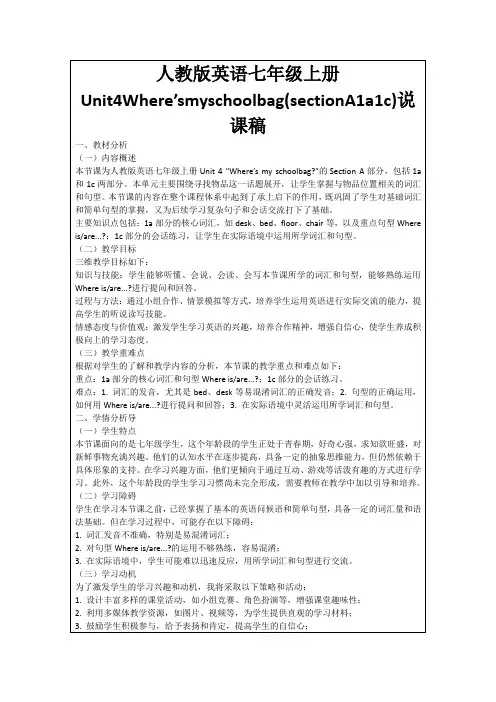
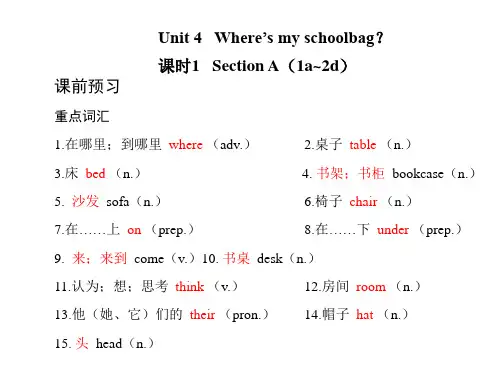
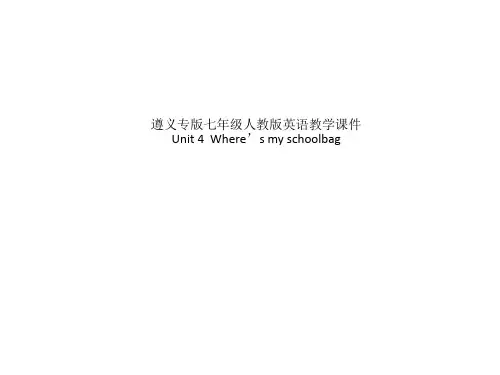
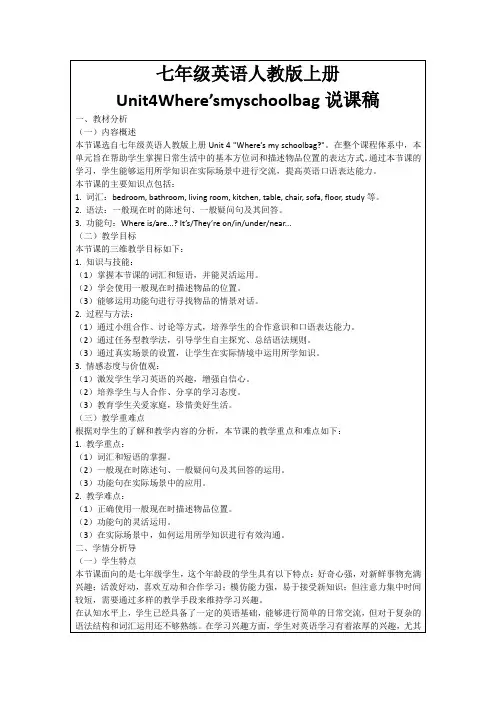
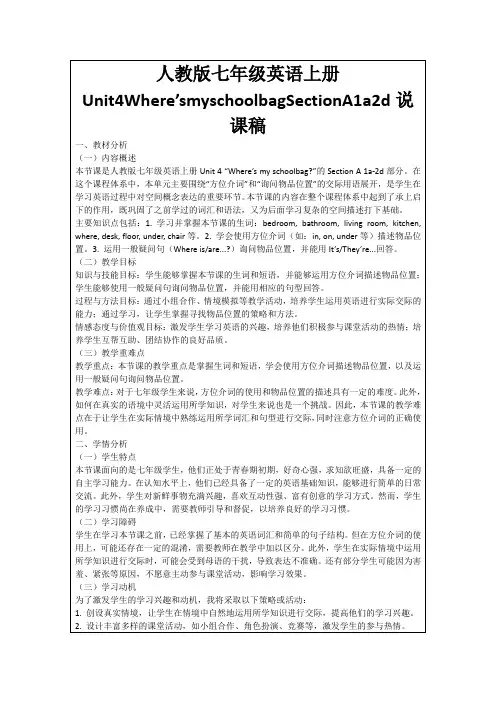
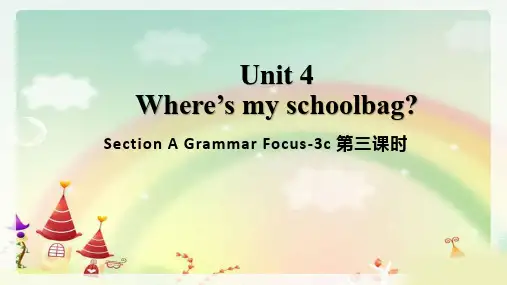
UNIT4 where’s my schoolbag (Section A GrammarFocus到3c部分说课稿)人教版七年级英语上学校:白腊乡高峰完全小学教师:王强各位老师,大家好!我今天说课的内容是人教版七年级英语上UNIT4 where’s my schoolbag Section A Grammar Focus到3c部分。
下面对我所要上的这节课作简要分析:一、教材分析:这节课的主要内容和任务是:学生能掌握方位介词is,on,under和where is/are句型;学生能熟练地运用这些方位介词和where is/are句型来询问和回答物体的具体位置;学生能进行口头交流。
由于在本节课之前已经学习了desk,key,chair,book,pencil,等物体的名词,为本节课铺垫了基础。
本节课在此基础上更深入一步。
运用这些物体名词,方位介词进行对话和交流。
通过本节课的学习,学生熟练掌握了询问和描述物体位置的方式方法,为下一个部分听录音写“汤姆的物品在哪里”打下了基础。
所以本节课承接了上一课的内容,更主要的是开启了下一节课的内容学习。
二、教学目标:根据新课标要求和学生实际出发,制定了一下教学目标:1.知识目标:(1)关键词know;where’s(2)目标语言Where’s the map? It’s in your grandparent’s room.Where are my books? They’re on the sofa.Where’s his pencil box? It’s in his schoolbag.Where’s your ruler? It’s under the chair.Where are their keys? They’re on the table.2. 能力目标:学生能熟练运用所学的介词描述物品的位置并进行口头情境的表达。
3. 情感目标:(1)能调动学生开口讲英语的积极性,激发学生英语学习的兴趣。
《Unit4 Where’s my schoolbag ?》说课稿教师:高亚妮各位老师你们好:我今天说课的内容是:人教版新目标七年级上册第四单元的第一课时。
一、说教材(一)教材分析:本课是人教版新目标英语七年级上册第四单元的第一课时。
本单元的话题是谈论物品的位置。
通过单元学习,要求学生在掌握物品的名称的基础上用方位介词熟练地表达物品的位置,并能对where问句进行提问并回答。
本课section A部分为两部分,第一部分主要围绕物品名称及位置进行思维(1a)、听力(1b)、会话(1c)三方面对where’s/where are…?句型进行训练。
我根据教材特点,将一些内容进行整合,把1b、1c合起来训练学生的听力及口头表达能力,让学生系统地学好本课的目标语言。
(二)、教学目标根据英语新课标,教材大纲的要求和学情(学生对感兴趣的话题较愿意表达)确立教学目标如下:1、知识目标(1)掌握本课的重点词汇。
chair、sofa、table、bed、bookcase、where、under、on、(2)掌握并灵活运用重点句型。
Where’s the schoolbag? It’s under the table .Where are the books ? They are on the sofa .(3)掌握方位介词on ,in ,under 的用法。
2、能力目标(1)学会描述物品的位置,并能就物品的位置进行提问和回答。
(2)能对方位介词in ,on ,under加以灵活运用。
(3)培养学生的语言运用能力和绘画能力。
3、情感目标培养学生学习英语的兴趣,乐于参与课堂活动的积极情感。
(三)教学重点和难点根据本课在教材中所处的地位和作用,我确立本课的重难点如下:1、重点:学习掌握用where’s/where are…?句型询问物品的位置和运用方位介词in ,on ,under描述物品的所在位置。
2、难点:能够准确运用方位介词in/on/under描述物品所在的位置。